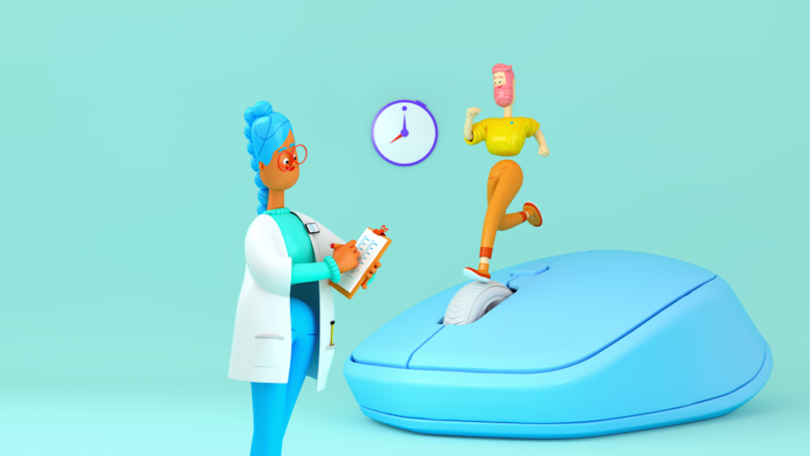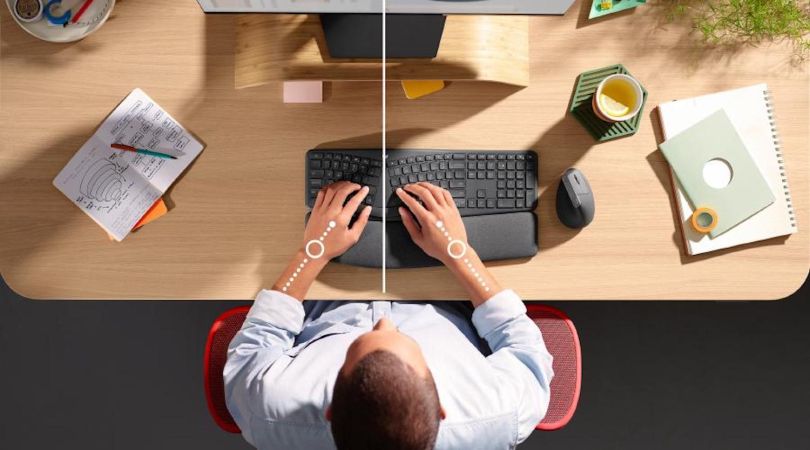“If you imagine yourself in a pool of water, if you completely relax, your body would go into a disposition where your hands are almost in the handshake position — because that’s where there’s the least pressure on them.”
Floating in a blissful state of nirvana may not be the first image that comes to mind when you’re envisioning your workstation posture, but it’s a mental model used by Lars Lauridsen, the senior global product manager at Logitech’s Ergo Lab in Switzerland, to conceptualize the anatomically ideal keyboard and mouse set-up: a pressure-free, neutral position in which our muscles, if freed from external stimuli, would naturally relax into a comfortable resting state.
“You might not think about it, but the keyboard and mouse are often the entry point to the digital world.”
For the average professional who spends about 30 percent of their time at work, small kinematic details of posture, wrist strain and pressure add up — and often not in a good way. About 15 percent of computer users in the United States experience pain or discomfort in the fingers, wrist, forearm, hand, shoulder or elbow on a daily basis.
“You might not think about it, Lauridsen said, “but the keyboard and mouse are often the entry point to the digital world. And when you look at how the usage accumulates over a year’s time, it’s actually quite significant, right?”

The Anatomy of Comfort
Pete Johnson, who is professor emeritus in the department of environmental and occupational health services at the University of Washington and sits on Logitech’s scientific advisory board, knows way more than you probably ever want to know about computer input devices.
He’s been an author of peer-reviewed studies on input force differences between touchscreen and conventional keyboards and analyses showing kids would benefit from mice roughly two-thirds the size of standard mice. He has also studied how women would benefit by having stature-proportional keyboards with smaller keys and lower activation forces, and that the conventional 104-key keyboard is unnecessary and comes at the expense of putting the mouse in a more strenuous position for your arms and shoulders.
A key thrust of Johnson’s work focuses on how input devices are often sized incorrectly and could be improved by incorporating anthropometry research and usability patterns more deliberately into designs.
“These disorders take years to accumulate. They go away, they get worse, then at some point the pain lasts all weekend and doesn’t dissipate.”
Prolonged, repetitive use of the mouse and keyboard, he said —particularly on improperly sized devices — can constrain blood flow and lead to cumulative trauma disorders, a cluster of injuries that can cause discomfort and, in some cases, debilitating damage to the tendons, nerves and soft tissues. One common example is carpal tunnel syndrome, a compression of the median nerve which affects 3-6 percent of the population.
“These disorders take years to accumulate. They go away, they get worse, then at some point the pain lasts all weekend and doesn’t dissipate,” Johnson said.
The mouse tends to be more problematic than the keyboard, he continued, especially in Windows environments, where it is most heavily used. Repetitive stress injuries often require significant time to heal, and can interfere with work and well-being, often “coming on at difficult times that push people over the edge, like a deadline at the end of an accounting cycle, or when people are working overtime,” he said.
In a sense, cumulative trauma disorders operate like compound interest in an investment portfolio: a few degrees difference in posture, like a higher interest rate, can have a significant impact over many years. These injuries can actually be mapped to The Law of Repetitive Motion, an equation expressed as “I=NF/AR, where “I” represents the total insult to the tissue, “N” is the number of repetitions, “F” is the force, “A” is the amplitude of motion, and “R” is the rest interval between repetitions. More on that later.

The Lean Research Loop
For now, this: Limiting the risk of musculoskeletal injuries and generally improving people’s comfort and productivity while working is a key mandate of the Ergo Lab, where teams of biomechanics researchers, engineers and designers conduct early validation testing for a suite of desktop products, including the Ergo k860 keyboard and MX Vertical and MX Ergo mice.
While I was speaking with Lauridsen over a video call, he showed me a short video of what goes on inside the lab. It’s a clean, open-plan studio filled with prototypes, computer screens displaying skeletal images, pressure mats, and electromyography and electrogoniometer sensors that measure electrical activity in the body.
“We can take quite crude prototypes, hook people up with the sensors and then simulate them typing.”
“We can take quite crude prototypes, hook people up with the sensors and then simulate them typing, right? And then we can understand how pronation [on an Ergo model] compares to a standard keyboard, how much wrist pressure there is and so forth,” Lauridsen said.
The results are used to refine prototypes, which are fabricated with 3D printers. If you’ve seen the winglike, tented designs of modern ergonomic keyboards or the curved silhouette of a vertical mouse, you get the idea.
During the video, Laleh Makarem, a senior sensor fusion engineer at the Ergo Lab, described the lab’s ultimate aspiration: to design tools that encourage a positive user feedback loop. “You feel better, so you do better. And if you do better, you feel better. It goes on and on. It’s the happy loop,” she said.
The theoretical basis for the happy loop, or the lean research loop, as it is sometimes called, has been well established for digital products, and is supported by research: a software study of 6,640 desktop and mobile sites found, not surprisingly, that user happiness correlates with the likelihood a person will repeatedly use a product and recommend it to others.
Interestingly, fewer than 5 percent of sites in that study, published on UX Booth — Apple, Ally and Amazon being notable exceptions — actually earned high happiness scores. Such high ratings would seem even more improbable in the realm of hardware, where the rewards are less obvious. You can download Goodfellas from Amazon. What does a mouse give you?
Then again, a mouse can get a lot of work done.
The Venn Diagram of Ergonomics: Economics, Comfort and Design
Lauridsen admits that, while comfort is important to the design of Logitech’s Ergo Series products, it’s not everything. The conceptual sweet spot they’re targeting exists at the center of a Venn diagram plotting economics, comfort and design. Their revenue model is at least partially tied to performance optimization.
“We want to make sure that our devices, even though they are designed to promote a more natural posture, don’t compromise on performance — so that the speed and accuracy is on par with what you expect,” he said.
Way back in 2008, Johnson led a study of an ergonomic keyboard design developed by Logitech called the Wave, which is a good illustration of how these factors are interdependent. In the study, 20 experienced touch typists were recruited from the University of Washington to use both a conventional keyboard and the Wave model for 30 minutes. Electrogoniometers and inclinometers measured wrist and forearm postures, software evaluated typing speed and accuracy, and participants self-reported their comfort and keyboard preferences.
“We want to make sure that our devices, even though they are designed to promote a more natural posture, don’t compromise on performance.”
The results, published in the journal Proceedings of the Human Factors and Ergonomics Society Annual Meeting, indicated that the Wave Keyboard, compared to a traditional keyboard “reduced wrist extension by 4.6 degrees (p < 0.01), ulnar deviation by 1.8 degrees (p = 0.02) and forearm pronation by 1.3 degrees (p = 0.08).”
But the keypad also reduced typing speed by 4 percent. These factors, as well as the appearance aesthetics, had to be kept in balance.

Form (Sometimes) Follows Function
American architect Louis Sullivan’s maxim “form ever follows function” is said to have lost relevance in the realm of digital products, which often bear little resemblance to what they do (though the size and prominent position of most “buy” buttons follows the manifesto fairly well). The phrase also still rings true in hardware design.
According to Lauridsen, a keyboard with a rounded back and elevated center aims to promote a more natural posture by limiting pronation (inward movement) and extension of the wrist.
“If you take the keyboard, for instance, the curve is playing on one of the dimensions of natural pressure,” he said. “So the gable in the middle really takes your wrist from being flat and pronated to a more natural posture. And, essentially, it’s the same thing that the mouse does. When you go from a flat mouse to a vertical mouse, it alleviates this pronation that you have in your wrist.”
The form of a split or splayed keyframe is also driven by its principal functions: comfort and performance.
“One of the things that happens when you’re typing on the keyboard,” Lauridsen said, “is you often have ulnar deviation, where you compress the ulnar nerve that runs on the outside of your hand, and you increase compression. When you split the keyboard, you actually remove that and have a more natural posture.”
In modern offices or home environments with height-adjustable desks, he continued, it is especially important for keyboards to tilt away from the body, rather than slope upward toward the rear keys, as is often the case, “because when you’re standing up from a table, your desk is a little bit lower, which means your arms come down at a sharper angle.”
But old habits die hard. Many people still type on flat keypads, hunch over laptops that sit way too low, or stab at the keys — all of which can trigger or exacerbate problems.
Ideally, Johnson said, you should sit at a desk with your feet flat on the floor, and your thighs parallel to the floor, or angled slightly downward, to limit the curvature of the lower back. Your elbow should form a 90 degree angle with the desk, or ever-so-slightly above that, when your arms are extended over the surface. Your eyes should gaze down on the screen at a roughly 15 degree angle.
“The current ‘one-size-fits-all’ paradigm for the design of computer input devices is unlikely to meet the needs of a large percentage of the computer-using population.”
Even with all this in mind, a common problem for the average person is that the standard desk is too tall — typically 28-29 inches, rather than 24-25 inches — according to Johnson, because the knee clearance is designed to accommodate the tallest male users. In a what he deems the “most important and relevant” study of his career, Johnson analyzed how anthropometric differences by age and gender can be incorporated into the design of computer input devices.
The study concludes that “with women and with children between 5 and 14 years of age representing 60 percent of the world population ... the current ‘one-size-fits-all’ paradigm for the design of computer input devices is unlikely to meet the needs of a large percentage of the computer-using population.”
He said the recommendations have still not been widely adopted by the industry. This may be an area for hardware companies to differentiate themselves: inclusive product development approaches that yield lines of smaller computers with smaller keys would likely have a receptive market. Workplace well-being has become a focal point of companies like Google and Salesforce, and is supported by a body of research showing it reduces health risks, cuts healthcare costs, increases productivity, reduces absenteeism, improves recruitment and retention, and promotes employee morale.

Ergonomics at Home Workstations
Meanwhile, as more organizations and workers have shifted to remote work, Logitech has seen an opportunity to be a knowledge source for employees looking to optimize their home offices, said Wendy Spander, the company’s senior global communications manager. The company recently published a list of guidelines for setting up ergonomic home workstations and tips for working from home.
“Our team’s done a fantastic job in the last six or eight weeks really turning our pages into places that you go not just to purchase products, but to find a lot of hints, tips and tools, because not only do we make the products we want to be there to help [users] figure out what’s the best,” Spander said.
While the new marketing strategy may be aimed at a different subset of the population, Lauridsen said, the focus on remote work will not slow down the usability research at the Ergo Lab. If anything, the lab may have to ramp up the scale and breadth of its testing to keep pace with the increased hours employees are working and where they are logging them.
“The fact that [people] now have to work from home, they might not have access to exactly the same things, and they spend more time sitting in the same posture.”
“It is a change in a lot of people’s lives, right?” he said. “The fact that they now have to work from home, they might not have access to exactly the same things, and they spend more time sitting in the same posture.”
There are undoubtedly some variables in The Law of Repetitive Motion that Logitech can do little to change, for instance, “N,” the number of repetitions, or “R,” the rest interval between repetitions.”
But the “A,” the amplitude of motion, and the “F,” the force of each keystroke, seem well within their wheelhouse.




